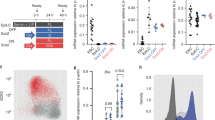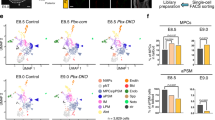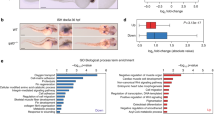Abstract
The transcription factor T-box 16 (Tbx16, or Spadetail) is an essential regulator of paraxial mesoderm development in zebrafish (Danio rerio). Mesodermal progenitor cells (MPCs) fail to differentiate into trunk somites in tbx16 mutants and instead accumulate within the tailbud in an immature state. However, the mechanisms by which Tbx16 controls mesoderm patterning have remained enigmatic. We describe here the use of photoactivatable morpholino oligonucleotides to determine the Tbx16 transcriptome in MPCs. We identified 124 Tbx16-regulated genes that were expressed in zebrafish gastrulae, including several developmental signaling proteins and regulators of gastrulation, myogenesis and somitogenesis. Unexpectedly, we observed that a loss of Tbx16 function precociously activated posterior hox genes in MPCs, and overexpression of a single posterior hox gene was sufficient to disrupt MPC migration. Our studies support a model in which Tbx16 regulates the timing of collinear hox gene activation to coordinate the anterior–posterior fates and positions of paraxial MPCs.
This is a preview of subscription content, access via your institution
Access options
Subscribe to this journal
Receive 12 print issues and online access
$259.00 per year
only $21.58 per issue
Buy this article
- Purchase on Springer Link
- Instant access to full article PDF
Prices may be subject to local taxes which are calculated during checkout






Similar content being viewed by others
Accession codes
References
Scaal, M. Early development of the vertebral column. Semin. Cell Dev. Biol. 49, 83–91 (2016).
Eckalbar, W.L., Fisher, R.E., Rawls, A. & Kusumi, K. Scoliosis and segmentation defects of the vertebrae. Wiley Interdiscip. Rev. Dev. Biol. 1, 401–423 (2012).
Hubaud, A. & Pourquié, O. Signalling dynamics in vertebrate segmentation. Nat. Rev. Mol. Cell Biol. 15, 709–721 (2014).
Turnpenny, P.D. et al. Novel mutations in DLL3, a somitogenesis gene encoding a ligand for the Notch signaling pathway, cause a consistent pattern of abnormal vertebral segmentation in spondylocostal dysostosis. J. Med. Genet. 40, 333–339 (2003).
Whittock, N.V. et al. Mutated MESP2 causes spondylocostal dysostosis in humans. Am. J. Hum. Genet. 74, 1249–1254 (2004).
Sparrow, D.B. et al. Mutation of the LUNATIC FRINGE gene in humans causes spondylocostal dysostosis with a severe vertebral phenotype. Am. J. Hum. Genet. 78, 28–37 (2006).
Sparrow, D.B., Guillén-Navarro, E., Fatkin, D. & Dunwoodie, S.L. Mutation of Hairy-and-Enhancer-of-Split-7 in humans causes spondylocostal dysostosis. Hum. Mol. Genet. 17, 3761–3766 (2008).
Holley, S.A. Anterior-posterior differences in vertebrate segments: specification of trunk and tail somites in the zebrafish blastula. Genes Dev. 20, 1831–1837 (2006).
Mallo, M., Vinagre, T. & Carapuço, M. The road to the vertebral formula. Int. J. Dev. Biol. 53, 1469–1481 (2009).
Kimmel, C.B., Kane, D.A., Walker, C., Warga, R.M. & Rothman, M.B. A mutation that changes cell movement and cell fate in the zebrafish embryo. Nature 337, 358–362 (1989).
Ho, R.K. & Kane, D.A. Cell-autonomous action of zebrafish spt-1 mutation in specific mesodermal precursors. Nature 348, 728–730 (1990).
Griffin, K.J., Amacher, S.L., Kimmel, C.B. & Kimelman, D. Molecular identification of spadetail: regulation of zebrafish trunk and tail mesoderm formation by T-box genes. Development 125, 3379–3388 (1998).
Ho, R.K. Cell movements and cell fate during zebrafish gastrulation. Dev. Suppl. 1992, 65–73 (1992).
Yamamoto, A. et al. Zebrafish paraxial protocadherin is a downstream target of spadetail involved in morphogenesis of gastrula mesoderm. Development 125, 3389–3397 (1998).
Griffin, K.J. & Kimelman, D. One-Eyed Pinhead and Spadetail are essential for heart and somite formation. Nat. Cell Biol. 4, 821–825 (2002).
Fior, R. et al. The differentiation and movement of presomitic mesoderm progenitor cells are controlled by Mesogenin 1. Development 139, 4656–4665 (2012).
O'Neill, K. & Thorpe, C. BMP signaling and spadetail regulate exit of muscle precursors from the zebrafish tailbud. Dev. Biol. 375, 117–127 (2013).
Szeto, D.P. & Kimelman, D. The regulation of mesodermal progenitor cell commitment to somitogenesis subdivides the zebrafish body musculature into distinct domains. Genes Dev. 20, 1923–1932 (2006).
Garnett, A.T. et al. Identification of direct T-box target genes in the developing zebrafish mesoderm. Development 136, 749–760 (2009).
Mueller, R.L., Huang, C. & Ho, R.K. Spatio-temporal regulation of Wnt and retinoic acid signaling by tbx16/spadetail during zebrafish mesoderm differentiation. BMC Genomics 11, 492 (2010).
Shestopalov, I.A., Sinha, S. & Chen, J.K. Light-controlled gene silencing in zebrafish embryos. Nat. Chem. Biol. 3, 650–651 (2007).
Yamazoe, S., Shestopalov, I.A., Provost, E., Leach, S.D. & Chen, J.K. Cyclic caged morpholinos: conformationally gated probes of embryonic gene function. Angew. Chem. Int. Edn Engl. 51, 6908–6911 (2012).
Rossi, A. et al. Genetic compensation induced by deleterious mutations but not gene knockdowns. Nature 524, 230–233 (2015).
Shestopalov, I.A., Pitt, C.L. & Chen, J.K. Spatiotemporal resolution of the Ntla transcriptome in axial mesoderm development. Nat. Chem. Biol. 8, 270–276 (2012).
Myers, D.C., Sepich, D.S. & Solnica-Krezel, L. Bmp activity gradient regulates convergent extension during zebrafish gastrulation. Dev. Biol. 243, 81–98 (2002).
Yamazoe, S., Liu, Q., McQuade, L.E., Deiters, A. & Chen, J.K. Sequential gene silencing using wavelength-selective caged morpholino oligonucleotides. Angew. Chem. Int. Edn Engl. 53, 10114–10118 (2014).
Payumo, A.Y., Walker, W.J., McQuade, L.E., Yamazoe, S. & Chen, J.K. Optochemical dissection of T-box gene-dependent medial floor plate development. ACS Chem. Biol. 10, 1466–1475 (2015).
Weinberg, E.S. et al. Developmental regulation of zebrafish MyoD in wild-type, no tail and spadetail embryos. Development 122, 271–280 (1996).
Kimmel, C.B., Warga, R.M. & Schilling, T.F. Origin and organization of the zebrafish fate map. Development 108, 581–594 (1990).
Warga, R.M. & Nüsslein-Volhard, C. Origin and development of the zebrafish endoderm. Development 126, 827–838 (1999).
Ando, R., Hama, H., Yamamoto-Hino, M., Mizuno, H. & Miyawaki, A. An optical marker based on the UV-induced green-to-red photoconversion of a fluorescent protein. Proc. Natl. Acad. Sci. USA 99, 12651–12656 (2002).
Bouldin, C.M. et al. Wnt signaling and tbx16 form a bistable switch to commit bipotential progenitors to mesoderm. Development 142, 2499–2507 (2015).
Amores, A. et al. Zebrafish hox clusters and vertebrate genome evolution. Science 282, 1711–1714 (1998).
Montavon, T. & Soshnikova, N. Hox gene regulation and timing in embryogenesis. Semin. Cell Dev. Biol. 34, 76–84 (2014).
Yu, P.B. et al. Dorsomorphin inhibits BMP signals required for embryogenesis and iron metabolism. Nat. Chem. Biol. 4, 33–41 (2008).
Wells, S., Nornes, S. & Lardelli, M. Transgenic zebrafish recapitulating tbx16 gene early developmental expression. PLoS One 6, e21559 (2011).
Kim, J.H. et al. High cleavage efficiency of a 2A peptide derived from porcine teschovirus-1 in human cell lines, zebrafish and mice. PLoS One 6, e18556 (2011).
Martin, B.L. & Kimelman, D. Regulation of canonical Wnt signaling by Brachyury is essential for posterior mesoderm formation. Dev. Cell 15, 121–133 (2008).
Martin, B.L. & Kimelman, D. Canonical Wnt signaling dynamically controls multiple stem cell fate decisions during vertebrate body formation. Dev. Cell 22, 223–232 (2012).
Yabe, T. & Takada, S. Mesogenin causes embryonic mesoderm progenitors to differentiate during development of zebrafish tail somites. Dev. Biol. 370, 213–222 (2012).
Neave, B., Holder, N. & Patient, R. A graded response to BMP-4 spatially coordinates patterning of the mesoderm and ectoderm in the zebrafish. Mech. Dev. 62, 183–195 (1997).
Row, R.H. & Kimelman, D. Bmp inhibition is necessary for post-gastrulation patterning and morphogenesis of the zebrafish tailbud. Dev. Biol. 329, 55–63 (2009).
Harvey, S.A., Tümpel, S., Dubrulle, J., Schier, A.F. & Smith, J.C. no tail integrates two modes of mesoderm induction. Development 137, 1127–1135 (2010).
Martin, B.L. & Kimelman, D. Brachyury establishes the embryonic mesodermal progenitor niche. Genes Dev. 24, 2778–2783 (2010).
Iimura, T. & Pourquié, O. Collinear activation of Hoxb genes during gastrulation is linked to mesoderm cell ingression. Nature 442, 568–571 (2006).
Denans, N., Iimura, T. & Pourquié, O. Hox genes control vertebrate body elongation by collinear Wnt repression. eLife 4, e04379 (2015).
Manning, A.J. & Kimelman, D. Tbx16 and Msgn1 are required to establish directional cell migration of zebrafish mesodermal progenitors. Dev. Biol. 406, 172–185 (2015).
Lengerke, C. et al. BMP and Wnt specify hematopoietic fate by activation of the Cdx-Hox pathway. Cell Stem Cell 2, 72–82 (2008).
Warga, R.M., Mueller, R.L., Ho, R.K. & Kane, D.A. Zebrafish Tbx16 regulates intermediate mesoderm cell fate by attenuating Fgf activity. Dev. Biol. 383, 75–89 (2013).
Westerfield, M. The Zebrafish Book (University of Oregon Press, 1995).
Kimmel, C.B., Ballard, W.W., Kimmel, S.R., Ullmann, B. & Schilling, T.F. Stages of embryonic development of the zebrafish. Dev. Dyn. 203, 253–310 (1995).
Sato, T., Takahoko, M. & Okamoto, H. HuC:Kaede, a useful tool to label neural morphologies in networks in vivo. Genesis 44, 136–142 (2006).
Mich, J.K., Payumo, A.Y., Rack, P.G. & Chen, J.K. In vivo imaging of Hedgehog pathway activation with a nuclear fluorescent reporter. PLoS One 9, e103661 (2014).
Thisse, B. & Thisse, C. High throughput expression analysis of ZF models consortium clones. ZFIN Direct Data Submission <http://zfin.org/search?q=High+throughput+expression+analysis+of+ZF+models+consortium+clones> (2005).
Hashimshony, T., Wagner, F., Sher, N. & Yanai, I. CEL-Seq: single-cell RNA-Seq by multiplexed linear amplification. Cell Rep. 2, 666–673 (2012).
Ellett, F., Pase, L., Hayman, J.W., Andrianopoulos, A. & Lieschke, G.J. mpeg1 promoter transgenes direct macrophage-lineage expression in zebrafish. Blood 117, e49–e56 (2011).
Acknowledgements
We thank C. Crumpton, B. Gomez and O. Herman of the Stanford Shared FACS Facility for technical assistance with flow cytometry, Z. Weng of the Stanford Sequencing Service Center for assistance with RNA library sequencing, I. Yanai and F. Wagner for assistance with sequence-read processing, S. Amacher (Ohio State University) for tbx16b104/+ zebrafish, M. Lardelli (University of Adelaide), G. Lieschke (Monash University) and H. Okamoto (RIKEN Brain Science Institute) for plasmids, and K. Mruk for helpful discussions. This work was supported by the NIH (DP1 HD075622, R01 GM087292 and R01 GM108952 to J.K.C.; P50 GM107615 to the Stanford Center for Systems Biology), an A.P. Giannini Foundation Fellowship for Medical Research (L.E.M.) and a Japan Society for the Promotion of Science Fellowship (S.Y.).
Author information
Authors and Affiliations
Contributions
A.Y.P., L.E.M. and J.K.C. designed the experiments. A.Y.P., L.E.M. and W.J.W. performed the experiments. A.Y.P., L.E.M. and J.K.C. analyzed data. S.Y. synthesized reagents for cMO preparation. A.Y.P. and J.K.C. wrote the manuscript.
Corresponding author
Ethics declarations
Competing interests
The authors declare no competing financial interests.
Supplementary information
Supplementary Text and Figures
Supplementary Results, Supplementary Tables 1–3 and Supplementary Figures 1–16. (PDF 7256 kb)
Ventral MPCs lacking Tbx16 function do not exhibit movement defects during gastrulation.
Time-lapse imaging of embryos injected with either Kaede-NLS mRNA alone or in combination with the tbx16 cMO and spot-irradiated in the ventral margin at 6 hpf. Optically targeted cells can then be identified by the red fluorescence of photoconverted Kaede-NLS protein. Morphogenetic movements from 6 hpf to 9 hpf were imaged at a rate of 1 frame/5 minutes, and the movie is shown at a rate of 10 frames (50 minutes of development)/second. Embryo orientations: ventral view, animal pole up. Scale bar: 200 μm. The same embryos were imaged at later stages to generate Supplementary Video 2 (MOV 1117 kb)
Ventral MPCs lacking Tbx16 function exhibit movement defects during somitogenesis.
Time-lapse imaging of embryos injected with either Kaede-NLS mRNA alone or in combination with the tbx16 cMO and spot-irradiated in the ventral margin at 6 hpf. Optically targeted cells can then be identified by the red fluorescence of photoconverted Kaede- NLS protein. Morphogenetic movements from 10.5 to 17 hpf were imaged at a rate of 1 frame/5 minutes, and movie is shown a rate of 10 frames (50 minutes of development)/second. Embryo orientations: lateral view, dorsal up. Scale bar: 200 μm. The same embryos were imaged at earlier stages to generate Supplementary Video 1. (MOV 3406 kb)
MPCs overexpressing hoxa13b exhibit movement defects during somitogenesis.
Time-lapse imaging of embryos injected with either tbx16:EGFP-P2A-mCherry-NLS or tbx16:EGFP-P2A-hoxa13b-NLS constructs at the 1- to 4-cell stage. Morphogenetic movements from 10.5 to 16.25 hpf were imaged at a rate of 1 frame/5 minutes, and movie is 29 shown a rate of 10 frames (50 minutes of development)/second. Embryo orientations: lateral view, dorsal up. Scale bar: 200 μm. (MOV 3383 kb)
Rights and permissions
About this article
Cite this article
Payumo, A., McQuade, L., Walker, W. et al. Tbx16 regulates hox gene activation in mesodermal progenitor cells. Nat Chem Biol 12, 694–701 (2016). https://doi.org/10.1038/nchembio.2124
Received:
Accepted:
Published:
Issue Date:
DOI: https://doi.org/10.1038/nchembio.2124
This article is cited by
-
Illuminating developmental biology through photochemistry
Nature Chemical Biology (2017)



